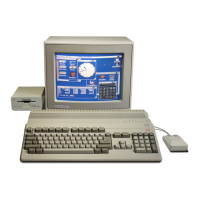
Do you have a question about the Commodore Amiga A1000 and is the answer not in the manual?
Lists the hardware components of the Amiga system.
Describes the main processor and the custom chips that enhance system performance.
Explains how peripheral devices can be added to Amiga models and the expansion capabilities.
Provides important notes and warnings for programmers working directly with Amiga hardware.
Explains the basic instructions (WAIT, MOVE, SKIP) of the Copper coprocessor.
Describes how the WAIT instruction pauses the Copper until a specific video beam position is met.
Explains the machine registers and strobe addresses dedicated to the Copper.
Guides on organizing and merging Copper instructions for display modifications.
Explains the procedures for initializing and stopping the Copper coprocessor.
Details how to access hardware registers to form a playfield the same size as the display screen.
Explains the 32 registers that define colors and how they are used for display.
Explains how to adjust horizontal and vertical resolutions for Amiga displays.
Explains how to define the on-screen display area by setting window start and stop positions.
Describes how to specify two playfields for a more flexible background display.
Outlines the process of defining a sprite and its characteristics.
Explains how sprite pixel colors are determined and selected.
Guides on constructing the sprite data structure in memory, including control and color information.
Explains how to display a sprite in automatic mode using sprite DMA.
Details how to move a sprite by specifying different positions in its data structure.
Guides on creating simple, steady sounds and playing them through audio hardware.
Details how to define waveform data, using a sine wave as an example.
Explains how to specify the sampling period to control sound frequency and pitch.
Covers factors to consider for achieving high-quality sound output.
Explains the phenomenon of aliasing distortion and how to avoid it.
Explains the four DMA channels (A, B, C, D) used by the blitter, including their registers.
Guides on using logic equations to design the LF control byte for blitter operations.
Provides guidelines for moving arbitrary rectangles of data between bitplanes.
Explains how blitter speed depends on enabled DMA channels and provides calculation formulas.
Discusses the blitter's effect on system performance, DMA priority, and time slot allocation.
Details how to use BPLCON2 bits to define object priorities and display order.
Explains how hardware detects collisions between sprites, playfields, and objects.
Covers the system's support for 68000 processor interrupts and their translation.
Describes the DMA functions and registers for enabling/disabling channels.
Details the nine-pin connectors for various controllers like mice, joysticks, and light pens.
Explains how to determine the positions of proportional input devices like paddles.
Describes the built-in controller's capabilities for handling MFM and GCR encoded disks.
Describes the 25-pin connector for serial peripherals like modems.
Explains how the SERPER register controls the serial port's transmission rate.
Control bits for audio, disk, and UART operations.
Blitter control register 0 for basic mode, area, and line operations.
Bit plane control register for misc. control bits.
Sprite pointer registers for DMA data addresses.
Color registers defining the Amiga's color palette.
Lists the pin designations, functions, and definitions for the Agnus chip.
Lists the pin designations, functions, and definitions for the Denise chip.
Lists the pin designations, functions, and definitions for the Paula chip.
Details the pin assignments for the Fat Agnus chip, used in later Amiga models.
Provides the address map for the CIAA chip's registers.
Lists the 16 readable/writable registers of each 8520 chip.
Explains the functional descriptions of I/O ports, handshaking, and interval timers.
Details the single register for interrupt masking and information.
Explains how the keyboard transmits 8-bit data words serially to the Amiga.
Lists hexadecimal values assigned to keyboard keys for data transmission.
Explains the feature available on some keyboards for initiating a computer reset.
Describes the 23-pin connector used for MFM data devices and its interface methods.
Explains the signals used by the driver to control disk operations like head positioning and motor.
Describes the method for establishing the type of disk attached via the interface.